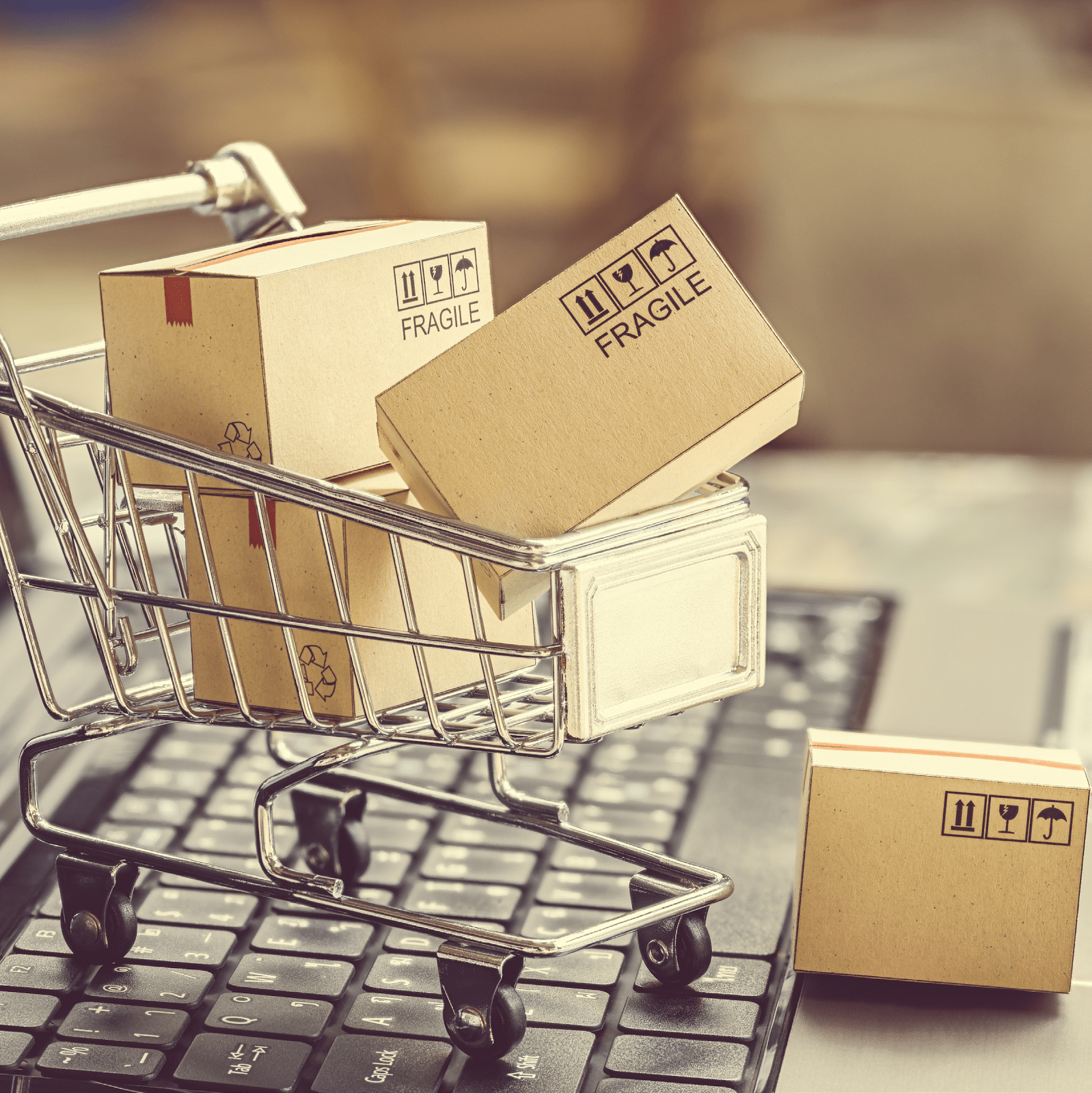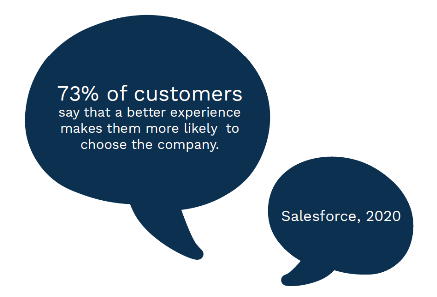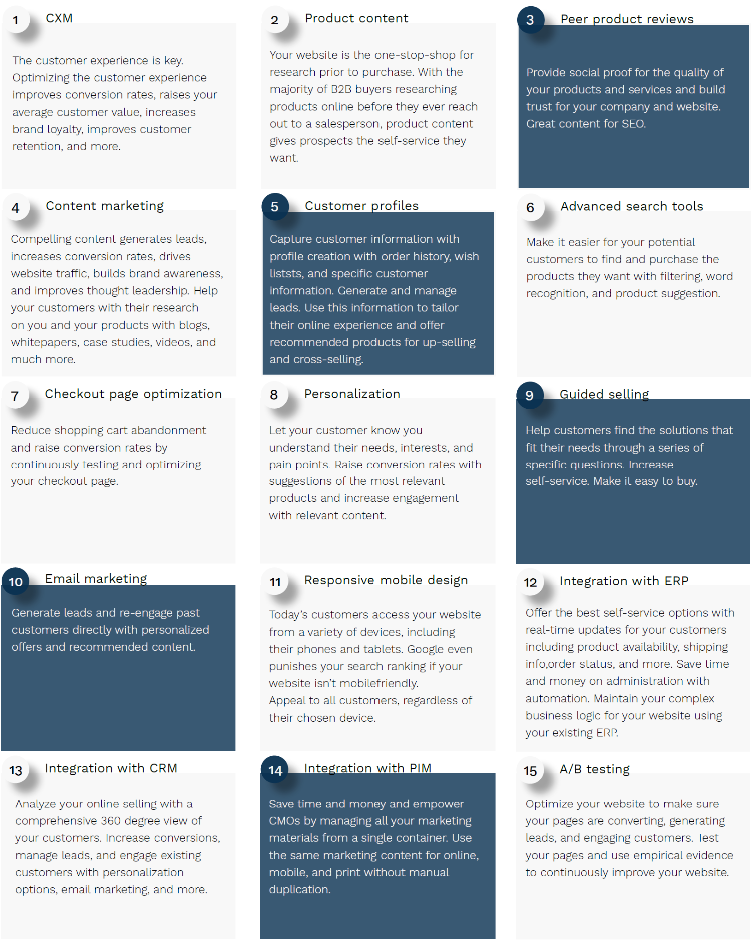Accelerate your DACH eCommerce – why you need more than a shopping cart
Written by
Editorial TeamPublished on

Do you want to know why some companies fail at online selling while others thrive? Well, the winners understand that in the impatient world of eCommerce, where your competition is merely a click away, optimizing the customer experience is crucial for successful eCommerce business.
Those businesses having trouble often underestimate what today’s customer demands from a satisfying online experience. This article shows you that having a webshop with a “Buy Now” button and a shopping cart are not enough to satisfy any customer accustomed to extensive self-service, and personalized eCommerce, when they do business online. Read on and discover how you can optimize your customer experience and accelerate your e-business!
In the digital age, your business needs more than an online shopping cart – it needs a complete eCommerce suite with all the tools you need to provide digital experiences that win over your customers and outpace your competition. This article summarizes the most important considerations regarding accelerating your customer experience.
Customer expirience
The power has shifted from the seller to the buyer. According to the latest report from Salesforce 73% of customers say that a better experience makes them more likely to choose the company.
Online B2B shoppers have come to expect features such as custom recommendations and one-click ordering because they base expectations on how they do business with Amazon and other large B2C enterprises. Whether your business is a giant like Amazon or a mid-market B2B wholesaler, customers expect the same great online shopping experience.

With high expectations and the ability to jump between eCommerce websites, in mere seconds, across multiple devices, customer experience rules the day. Customer experience is key to determining which visitors become customers and which wander away empty handed. This is why Customer Experience Management, or CXM, has risen to the forefront of online selling and online marketing.
Product content makes it easier to research
If your customers cannot navigate your website with ease and find what they are looking for, then you frustrate them. And you lose them. Product specifications, pricing, and even the amount of stock in your inventory all help customers make informed decisions about what you have to offer.
These product details you already have, and likely keep updated, in your Enterprise Resource Planning solution (more on this later,) so why not go ahead and offer this data to your customer? Looking for access to this information is a primary reason potential customers initially visit your site.

Rich product descriptions and high-quality product images go a long way towards helping customers understand how your products work and why they want those products. One picture is worth a whole lot of text, and product pictures encourage your site guests to visualize using your products to solve their pain points.
Content marketing engages customers
Content marketing increases conversion rates, generates leads, builds thought leadership, and raises brand awareness. The premise of content marketing is simple: Content that truly interests your customers entices them to become engaged, read more on your site, and even fill out lead forms that exchanges their contact information for further content. The ability to move customers further along the funnel with compelling content is another feature of eCommerce that is critical these days and exists far outside the shopping cart.
Types of content
As part of the research phase of their purchase, customers want to know about the products, the vendor, and even your views on your industry and business in a wider context. Especially for B2B sales, which often take months to gain approval through several layers of management before the final purchase.
There are several types of content that work (and work in tandem) to attract customers to your site, to engage them, and to assist them in their self-service research. For website visitors who want to learn about you as a vendor, an “About Us” page goes a long way. Other types of content could be:
Company blogs provide another outlet to show who you are and what your brand stands for. More informal than research papers, blogs allow your marketing team a chance to show some personality and prove to your customers that there is really a caring person behind the business. It’s important for building trust and an emotional connection with the customer.
Whitepapers, with more in-depth content, are particularly useful for informing your customers about how your products and solutions resolve their problems. Whitepapers require research and time to create, so they are often gated behind landing pages that include lead forms. Customers are often more willing to share their contact information with a vendor when they’re actively interested in a piece of content the vendor has to give.
Video content, especially in the age of speedy Internet, is a desired feature and comes in many forms, from testimonials to instructional videos to branded content. Video marketing is one of the most effective types of content for promoting services or products online. Being both easy adaptable and profitable, video is the perfect cocktail to boost your conversions.
Case studies further help prospects visualize and understand how solutions and implementations actually work in practice.
Make it easy to buy – and rebuy
One way your site makes it easier to buy from you is by storing the wish lists, order history, and saved shopping carts of your customers. These options provide customers with self-service options that facilitate their steps on the path to conversion.

Wish lists are effective for customers who like to continually add products throughout the research phase. Wish lists constantly remind your prospect about products of interest.
Order history is a helpful tool for returning buyers. Instead of searching through your site another time for the same products, repeat customers appreciate the quick and easy ability to reorder products with minimal clicks.
Give your customer the option to create a login to open the possibilities for instant recall of their order history and wish lists. These options save them time, which is great for them, and remind potential customers of products they want to buy, which is great for you.
If your customer prefers to make a purchase without creating or using a login, however, don’t force them. Instead, offer the ability to checkout as a guest.
Introduce advanced filtering options (for different parameters of your products) for the search function on your website, to make it even easier for your customers to find what they are looking for.
Optimize your checkout page to prevent potential customers from abandoning their shopping cart. This includes shortening the customer journey (reducing the number of pages to click through), offering various payment methods and polishing the look and feel of the checkout page.
These features are all designed to improve the customer experience, which as discussed, has a major effect on your business.
Personalization
Personalization is a feature where parts of your website adapt to present each customer the content that is most relevant for them. The reason for this is simple. If content is more relevant to your website visitor, there’s a better chance they’ll engage with your site and your company. If a product is extremely relevant to their needs, there’s a better chance for conversion and to close that sale.
Every move a visitor, a prospective customer, makes on your website offers you a detail about that customer. Those details can be applied to affect the next thing that the visitor is shown on your site and are precisely what makes personalization work. By utilizing the information gathered from visitor behavior, tracking where your visitor comes from and tracking what your visitor clicks on, for example you can use data so that your site begins to present relevant content that this particular visitor is likely to want. Dynamically, your site changes to make it easier to buy.

You gain even more information from your customers when they create profiles on your website. Even for the simplest profiles, demographic and geographic information are important to have. For example, if you sell seasonal products, it matters if your customer is from another hemisphere!
Personalization works by using customer profiles – also known as personas. Your marketing and sales teams work together to create profiles identifying the types of customers you are targeting. As a broad example, we know customers that buy printers need ink and paper. These easy-to-setup profiles are then used by your website to give customized experiences to customers who fit into the established categories.
You want to access to online behavioral analysis, customer history, and other details to identify and categorize customers. You then use these customer profiles to predict what those customers are interested in. All of this information empowers your website to offer those visitors the most relevant products and content. And the best part of personalization is that this recommendation process is all automated. And the research we shared shows that it works! The right online business solution provides you with the resources to effectively establish and use customer profiles.
Mobile matters today
This paper has covered the types of content and features that are essential to eCommerce success with the modern consumer. But how are customers actually accessing your website? According to research done by Statscouner, GlobalStats, the overall web traffic worldwide from August 2020 came fore and foremost generated through mobiles. Exactly, 51.33% mobile taffic, 45.9% came from desktop and the last 2.78% via tablets. The idea that your website only has to look and perform great on a desktop is out of date.
Your customers, right now, are using mobiles, not just for research and browsing, but also for shopping. Mobile is here to stay. Device hopping is also not unusual. Users start browsing on one device, add an item to their shopping cart on another device, and complete the transaction on a third. If your website doesn’t give the same great user experience across multiple devices, you forfeit potential customers to your competition.
Email marketing is marketing in a digital age
Another way to leverage the power of personalization is through email marketing. Email gives you direct contact to customers, and personalization works to ensure your emails are relevant to your ideal consumer. In fact, according to Leadforensics, some organizations see their email marketing provide B2B leads that account for 58% of all revenue. The same principles apply for personalized emails as for dynamic website content. The more your marketing aligns with the needs and interests of your potential customer, the greater chance you have at conversion, lead generation, further engagement, or other business objectives. According to Campaign Monitor, Marketers report a 760% increase in email revenue from personalized and segmented campaigns.
Shopping cart abandonment
Shopping cart abandonment, in particular, is an inherent risk when doing business in the endlessly distracting realm of the Internet. It’s a problem that plagues even the most successful eCommerce sites. Many prospective customers search websites, find appropriate products, add those products to their shopping cart, and then, for one reason or another, they leave the site.
If your eCommerce solution only features a shopping cart function, the story ends there. But with personalized email marketing, you have a chance to reengage that potential customer. After a website visitor abandons their shopping cart, you might choose to send them a friendly reminder about the product in their cart. Personalized emails also give you the ability to send other related product suggestions, content or discount codes to further entice the customer back to your website.

Emails for customer retention
Personalized emails are also great for retaining customers. Simple follow-up emails on past purchases are opportunities for cross-selling related products and recommending others. Emails that make special offers or include information about new products and promotions are also effective at reengaging customers. And by using the customer’s profile information, you increase your chances that each recommended product and piece of content is relevant to that prospect.
How integration optimizes your customer experience
Many of the mentioned features rely on information you probably already have in your backend systems: Inventory from your Enterprise Resource Management (ERP) solution, customer data from your Customer Relationship Management (CRM), and product descriptions from your Product Information Management (PIM). Rather than make infeasible attempts to duplicate all this massive data into your eCommerce solution, you want a high-quality eCommerce solution that seamlessly integrates with your backend systems. Integration saves you time and money related to administration because all related data is managed from its original source.
Integration with ERP and Business Logic
ERP systems store important data and business logic. Integrated eCommerce gives you the ability to update your ERP and have the new data instantly reflected on your website. These real time updates provide your online customers with the most up-to-date information, which is crucial for self-service.
One simple example of the important data in your ERP is your product availability. Automatic updates to your website prevent online customers from attempting to order products that are out of stock or no longer available. This reduces customer frustration and improves both their overall experience with your site and their impression of your brand as a whole.
Integration also gives your online consumers access to customer-specific pricing, quantity discounts, and accurate shipping terms, while letting those systems handle complex interactions and rules, such as warehousing, freight, multiple shipping addresses, and more. The ideal eCommerce solution takes over selling and online marketing.
Integration with CRM
Your Customer Relationship Management system is another backend system that greatly benefits your business when integrated with your eCommerce website. As discussed, personalization is critical to the modern online business. Capturing information about your website visitor is central to tailoring their experience, and your CRM is the place where you store customer information.
Seamless integration with your CRM and eCommerce solution gives you the ability to analyze this information together as a single, comprehensive 360 degree view of your customer. From behavioral tracking on your website to email correspondence and everything in between, this holistic approach to viewing your customer empowers you to target their needs and interests with more precision. Deploying this knowledge with your personalization and email marketing raises conversion rates and engagement.
Integration with PIM
Product Information Management is a multichannel marketer’s best friend. Many marketing teams must disseminate their marketing content across a number of different channels, such as newsletters, print brochures, websites, mobile apps, and more. A PIM system gives marketers the ability to go from print to website publishing without manually duplicating or recreating content such as product catalog data.
PIM solutions save time and money by enabling CMOs to manage their marketing content from a single container. Both written content and images are managed within the Product Information Management System.
For exampe, Dynamicweb PIM integrates with Adobe InDesign and Easy Catalog among others, to give you even more control over marketing content. Additionally, integration between eCommerce and PIM lets you create search filters and fields in the PIM system and then use those same functions for your eCommerce site.
A handy guide

Summary – more than a shopping cart
- Make it easy to research
- Make it easy to buy
- Offer compelling content about your products, industry, and brand
- Personalize the customer experience and guide your customers towards relevant products and content
- Send customized emails to your customers
- Optimize your site for whatever mobile or large screen device those customers decide to use
These actions are proven to raise conversion rates, increase your average order values, increase brand loyalty, retain more customers, and grow your business. To reach your business goals, it takes more than a shopping cart. Personalization, content marketing, automation, advanced site search, email marketing, integration, and mobile responsive design are the critical tools for today’s eCommerce.Today’s online customer has high expectations in their demands for self-service. And if your website doesn’t offer the best customer experience, your competition is just a click away.
About Dynamicweb
Dynamicweb offers customers an industry recognized, award winning, all-in-one cloud eCommerce Suite. We enable customers to deliver stellar customer experiences and to scale eCommerce success through the best-in-class Content Management, Digital Marketing, eCommerce and Product Information Management solutions.
Dynamicweb’s 300+ partners, 200+ employees in offices all around the globe are proud to support well over 4.000 brands, which includes leading brands like Lego, Vredestein, Unilever, Winnebago, L’Oréal, Flying Tiger, Toyota and Europcar. Build on Dynamicweb they are empowered to gain lifelong customer relations, increase revenue and grow their brands. Today, thousands of businesses run more than 12,000 websites with Dynamicweb. We are expanding our services internationally in close corporation with 200 certified partners in 13 countries.

Find out more www.dynamicweb.com.


